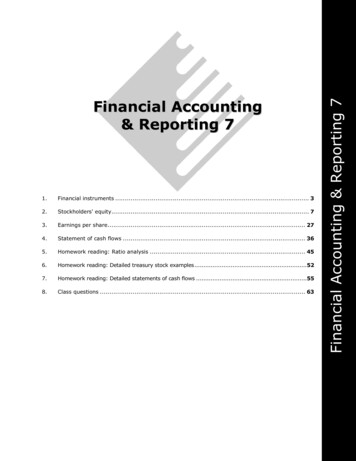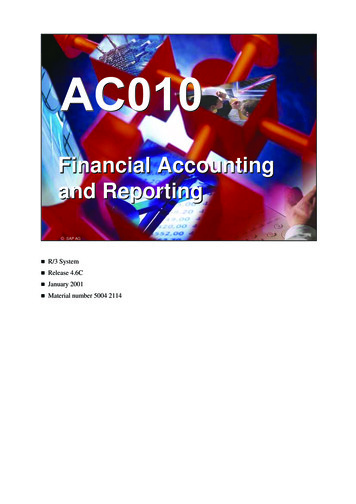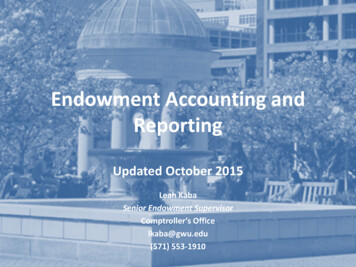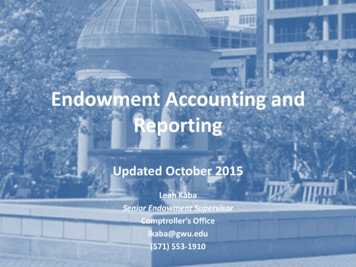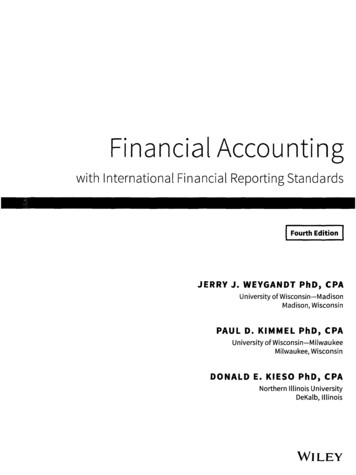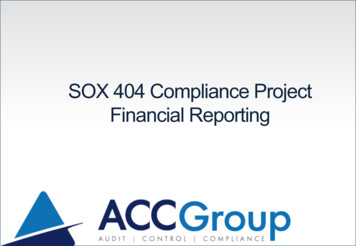
Transcription
1.Working capital and its components . 32.Inventories . 203.Fixed assets. 334.Depreciable assets and depreciation . 405.Fixed asset impairment . 516.Homework reading: Enhanced outlines and expanded examples of inventory. 537.Homework reading: Transfers and servicing of financial assets (SFAS No. 140). 728.Class questions . 75Financial Accounting & Reporting 4Financial Accounting& Reporting 4
F4-2
Becker CPA ReviewFinancial Accounting & Reporting 4WORKING CAPITAL AND ITS COMPONENTSI.INTRODUCTION TO WORKING CAPITALA.WORKINGCAPITALWORKING CAPITALWorking capital is defined as current assets minus current liabilities. It is often a measure ofthe solvency of a company and is used in many financial ratios for analysis purposes.1.Working CapitalCurrent Assets Current Liabilities2.Current RatioCurrent AssetsCurrent Liabilities3.Quick RatioCash Net Receivables Marketable SecuritiesCurrent LiabilitiesB.CURRENT ASSETSCURRENTASSETSCurrent assets are those resources that are reasonably expected to be realized in cash, sold,or consumed (prepaid items) during the normal operating cycle of a business or one year,whichever is longer. Current assets typically consist of:1.Cash,2.Trading securities,3.Other short-term investments (individual available-for-sale securities if liquidation isanticipated within the operating cycle or one year, whichever is longer),4.Accounts and notes receivable,5.Trade installment receivables,6.Inventories (discussed later in this module),7.Other short-term receivables,8.Prepaid expenses, and9.Cash surrender value of life insurance. Cash surrender value of life insurance can be acurrent asset or a non-current asset depending on intent. If the policy owner intends tosurrender the policy for its cash surrender value during the normal operating cycle, itwould be a current asset; if the policy owner does not intend to surrender the policy, asis normal, it would be a non-current asset. If an insurance policy has a cash surrendervalue, any portion of the premium payment that does not add to that cash surrendervalue is expensed. 2009 DeVry/Becker Educational Development Corp. All rights reserved.F4-3
Financial Accounting & Reporting 4C.CURRENTLIABILITIESBecker CPA ReviewCURRENT LIABILITIESCurrent liabilities are obligations whose liquidation is reasonably expected to require the useof current assets or the creation of other current liabilities. Obligations for items that haveentered the operating cycle should be classified as current liabilities. The concept of currentliabilities includes estimates or accrued amounts that are expected to be required to coverexpenditures within the year for known obligations (1) when the amount can be determinedonly approximately (e.g., provision for accrued bonuses payable), or (2) where the specificperson(s) to whom payment will be made is unascertainable (e.g., provision for warranty of aproduct).Current liabilities are an important indication of financial strength and solvency. The ability topay current debts as they mature is analyzed by interested parties both within and outside thecompany.1.Sources of Current LiabilitiesCurrent liabilities may arise from regular business operations (as is the case ofaccounts payable and wages payable) or to meet cash needs through bankborrowings.2.Types of Current LiabilitiesCurrent liabilities typically consist of:3.a.Trade accounts and notes payable,b.Current portions of long-term debt,c.Cash dividends payable,d.Accrued liabilities,e.Payroll liabilities,f.Taxes payable, andg.Advances from customers (deferred revenues if expected to be recognized withinone year).Classification of Short-Term Obligations Expected to Be RefinancedA short-term obligation may be excluded from current liabilities and included innoncurrent debt if the company intends to refinance it on a long-term basis and theintent is supported by the ability to do so as evidenced either by:a.The actual refinancing prior to the issuance of the financial statements, orb.The existence of a noncancelable financing agreement from a lender having thefinancial resources to accomplish the refinancing.The amount excluded from current liabilities and a full description of the financingagreement shall be fully disclosed in the financial statements or notes thereto.F4-4 2009 DeVry/Becker Educational Development Corp. All rights reserved.
Becker CPA ReviewII.Financial Accounting & Reporting 4CASH AND CASH EQUIVALENTSCASHCash includes both currency and demand deposits with banks and/or other financialCASHinstitutions. It also includes deposits that are similar to demand deposits (can beEQUIVALENTSadded to or withdrawn at any time without penalty). The term cash equivalentsbroadens the definition of cash to include short-term, highly liquid investments that are both readilyconvertible to cash and so near their maturity when acquired by the entity (90 days or less fromdate of purchase) that they present insignificant risk of changes in value.A.B.C.EXAMPLES OF CASH AND CASH EQUIVALENTS1.Coin and currency on hand (including petty cash)2.Checking accounts3.Savings accounts4.Money market funds5.Deposits held as compensating balances against borrowing arrangements with alending institution that are NOT legally restricted6.Negotiable papera.Bank checks, money orders, traveler's checks, bank drafts, and cashier's checksb.Commercial paper and Treasury billsc.Certificates of deposit (having original maturities of 90 days or less)ITEMS NOT CASH OR CASH EQUIVALENTS1.Time certificates of deposit (if original maturity over 90 days)2.Legally restricted deposits held as compensating balances against borrowingarrangements with a lending institutionRESTRICTED OR UNRESTRICTEDCash is classified as unrestricted or restricted. Restricted cash is cash that has been setaside for a specific use or purpose (e.g., the purchase of property, plant, and equipment).Unrestricted cash is used for all current operations. The nature, amount, and timing ofrestrictions should be disclosed in the footnotes.1.If the restriction is associated with a current asset or current liability, classify as acurrent asset but separate from unrestricted cash.2.If the restriction is associated with noncurrent asset or noncurrent liability, classify as anoncurrent asset but separate from either the Investments or Other Assets section.3.Examples of restrictionsa.If any portion of cash and cash equivalents is contractually restricted because offinancing arrangements with a credit institution (called a compensating balance),that portion should be separately reported as "restricted cash" in the balancesheet.b.If any portion of cash and cash equivalents is restricted by management, itshould be reported as restricted cash and as a current or long-term asset(depending on the anticipated date of disbursement).c.Some industries (such as public utilities) report the amount of cash and cashequivalents as the last asset on the balance sheet because they report assets ininverse order of liquidity. 2009 DeVry/Becker Educational Development Corp. All rights reserved.F4-5
Financial Accounting & Reporting 4Becker CPA ReviewItems Included in Cash BalanceEXAMPLESmith Corporation's cash ledger balance on December 31, Year 7, was 160,000. On the same dateSmith held the following items in its safe: A 5,000 check payable to Smith, dated January 2, Year 8 that was not included in the December31 checkbook balance. A 3,500 check payable to Smith, deposited December 22 and included in the December 31checkbook balance, that was returned NSF. The check was re-deposited January 2, Year 8 andcleared January 7. A 25,000 check, payable to a supplier and drawn on Smith's account, that was dated andrecorded December 31, but was not mailed until January 15, Year 8.In its December 31, Year 7 balance sheet, what amount should Smith report for cash?Smith's cash balance is calculated as follows:Unadjusted balance of Smith's Cash Ledger Account, December 31,Year 7Add: Check Payable to supplier dated and recorded onDecember 13, Year 7, but not mailed until January 15, Year 825,000Less: NSF check returned by bank on December 30, Year 7(3,500)Adjusted balance, December 31, Year 7D. 160,000 181,500BANK RECONCILIATIONSThere are two general forms of bank reconciliations. One form is called a simplereconciliation. The other widely used form is entitled reconciliation of cash receipts anddisbursements.1.Simple ReconciliationDifferences between the cash balance reported by the bank and the cash balance perthe depositor's records are explained through the preparation of the bank reconciliation.Several factors bring about this differential.a.Deposits in TransitFunds sent by the depositor to the bank that have not been recorded by the bankand deposits made after the bank's cutoff date will not be included in the bankstatement. In both cases, the balance per the depositor's records will be higherthan those of the bank.b.Outstanding ChecksChecks written for payment by the depositor that have not been presented to thebank will result in a higher balance per bank records than per depositor records.c.Service ChargesService charges are deducted by the bank. The depositor will not deduct thisamount from its records until it is made aware of the charge, usually in thefollowing month. Balance per books is overstated until this amount is subtracted.d.Bank CollectionsThe bank may make collections on the depositor's behalf, increasing thedepositor's bank balance. If the depositor is not aware the collection wascredited to its balance, the balance per depositor's records will be understated.F4-6 2009 DeVry/Becker Educational Development Corp. All rights reserved.
Becker CPA ReviewFinancial Accounting & Reporting 4e.ErrorsErrors made by either the bank or the depositors are another cause fordifference.f.Nonsufficient Funds (NSF)The bank may have charged the depositor's account for a dishonored check andthe check may not have been redeposited until the following month. This wouldoverstate the depositor's book balance as of the balance sheet date.g.Interest IncomeUsually the depositor does not keep track of average daily cash balances, and sowill add this amount to its records once made aware of this revenue. Balanceper books is understated until this amount is added.h.Example of a Simple Bank ReconciliationAlthough other methods can be used, the most common procedure is toreconcile both book and bank balances to a common "true" balance. Thatbalance should then appear on the balance sheet under the caption "Cash andCash Equivalents."Procedures:(1)Book balance is adjusted to reflect any corrections reported by the bank(e.g., NSF checks, notes collected by the bank and credited to the account,monthly service charges, and other bank charges such as check printingcharges).(2)After the above adjustments are made,ADJUSTED BOOK BALANCE TRUE BALANCE.(3)The bank balance per the bank statement is reconciled to the "truebalance" determined above.Simple Bank ReconciliationBurbank Company's records reflect a 12,650 cash balance on November 30, Year 3.Burbank's November bank statement reports the following amounts:Cash balanceBank service chargeNSF check 10,0501090EXAMPLEDeposits in transit equal 3,000 and outstanding checks are 500.What is Burbank's November 30, Year 3 adjusted cash balance?Bank Reconciliation for November Year 3Balance per books 12,650Less: Bank service charge 10(100)NSF check90Adjusted cash balance 12,550Balance per bankAdd: Deposits in transitLess: Outstanding checksAdjusted cash balance 2009 DeVry/Becker Educational Development Corp. All rights reserved. 10,0503,000 13,050(500) 12,550F4-7
Financial Accounting & Reporting 42.Becker CPA ReviewReconciliation of Cash Receipts and DisbursementsThe reconciliation of cash receipts and disbursements, commonly referred to as thefour-column reconciliation or proof of cash, serves as a proof of the proper recording ofcash transactions.Additional information is required in preparing the four-column reconciliation. The bankreconciliation information for the present month and that of the prior month must beobtained.The object of the four-column approach is to reconcile any differences between theamount the depositor has recorded as cash receipts and the amount the bank hasrecorded as deposits. Likewise, this approach determines any differences betweenamounts the depositor has recorded as cash disbursements and amounts the bank hasrecorded as checks paid.Four-Column ApproachBased on the information in the previous example and additional information for the monthof December, Burbank's reconciliation of cash receipts and disbursements follows:Burbank CompanyReconciliation of Cash Receipts and Cash DisbursementsFor the Month of December, Year 3EXAMPLEBalanceNovember 30,Year 3F4-8Balance per depositor's booksNote collected by bankBank service chargeNSF check received fromcustomerError in recording check #350Adjusted balancesBalance per bank recordsDeposit in transit:November 30December 31Outstanding checks:November 30December 31NSF checkAdjusted balances 12,550DecemberReceiptsDecemberPayments 12,9503,050 4,94815(285) 12,550 10,050 15,715 15,0003,000(3,000)4,000(500) 12,550(285) 15,71554 5,017 2,400BalanceDecember 31,Year 3 20,5523,050(15)(285)(54) 23,248 22,6504,000(500)3,402(285) 5,017(3,402) 23,248 2009 DeVry/Becker Ed
four-column reconciliation or proof of cash, serves as a proof of the proper recording of cash transactions. Additional information is required in preparing the four-column reconciliation.


